Eric’s latest adventures aboard Race for Water.
The dinner bell—actually a conch shell, a gift from the ship’s first crew—sounds across Race for Water’s aft deck, which has been repurposed into a dining hall for the trip. It’s 1 PM and we’re sailing off the coast of Cuba. Despite the trade winds blowing from the north, the heat is getting on everyone’s nerves. We’re constantly searching for places to cool off, and the dining hall is one of them, offering a rare and welcome cross-breeze. Olivier emerges from the kitchen—dripping with sweat, like some mythical creature rolling and swaying—as we all do when the wind and waves are behind us— carrying our lunch. Today’s menu relies on the fresh fruits and vegetables that we bought at the incredible market in Havana the day before we left.
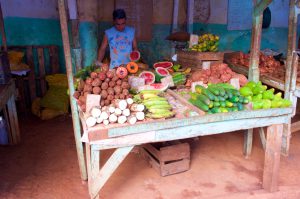
It’s been few days since we set off from our polluted mooring at Havana’s Sierra Maestra terminal. Ironically, Race for Water—an ambassador for the environment and the energy transition—was docked alongside an enormous cruise ship, surely one of the ocean’s biggest polluters. Our last night in Havana unfolded just as we’d hoped: in a classic Cuban bar where we indulged in a good amount of local beer, partying to the energetic sounds of a local orchestra as some very attractive…let’s call them ladies of the evening…looked on.
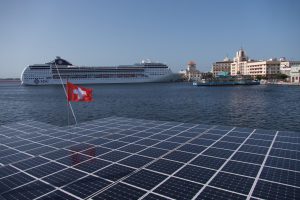
Now we’re cruising along the endless, monotonous north coast of Cuba. It’s lined with huge lagoons bordered by green mangrove trees and white sand beaches, and everywhere we see concrete structures springing up, as the Cuban people throw themselves onto the lifeboat of mass tourism as a way out of their precarious existence. The picture-perfect coastline is now dotted with more cranes than palm trees…and I’m only half joking!
A bit of background: We finally left Havana more than 12 hours ahead of schedule. As our captain said, “At least there’s that!” Our spot at the dock was taken by another behemoth cruise ship that sails around polluting the oceans, and it disgorged its mob of tourists into Havana’s old town. We were relegated to a dirty and unpleasant mooring directly under the filthy exhaust from the oil refinery’s smokestacks—built upwind from the bay and the city, who knows why?
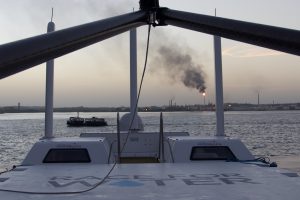
On Sunday I went grocery shopping with our quartermasters, Olivier and Bérangère. We’ll be at sea for at least 15 days with no plans or really any opportunity to dock before we get to Santo Domingo. The shopping trip was my chance to check out the status of the local agriculture, and what’s going on with organic farming in Cuba. Remember that back in the 80s, Cuba fell into a deep recession due to the US embargo and the fall of the Soviet Union. Partially out of necessity and partially because of Fidel Castro’s preferences, Cuba became a leader in sustainable agriculture, a system that’s been so problematic to set up in Europe. Between the food embargo and the petroleum shortage, the Cubans had to grow what they ate, whether they lived in rural areas or in cities. In Havana, many residential neighborhoods were transformed into gardens, fertilized with organic matter instead of chemicals. Since the return of petroleum and the purported end of the recession, those responsible environmental practices are dying out. But the fruits and vegetables we bought were very fresh, even in a modest local market—a sweet, green oasis shoehorned between a few sad buildings. The farmer running the stand—Lazarro—told us that his produce came directly from the nearby fields, and it was all organic. We bought tomatoes, greens, cucumbers just like at home…but also mangoes and giant avocadoes that only grow in Cuba, and that we’ll surely enjoy out at sea.
Unfortunately, Havana has almost no community gardens now. They’ve been replaced by two identical supermarkets—exactly like those we’d find at home. They’re overwhelmed with business. Other than the market I mentioned, there’s almost nowhere to buy fresh produce. That’s one reason why the average Cuban eats very poorly, gorging on cheap sweets and fatty foods that contribute to obesity. You might wonder how people get by, given that a doctor might earn 40 euros a month; a blue-collar worker maybe 20 euros, while a liter of milk costs five euros. Creativity is the operative word; Cubans call it conseguir, meaning “to make something out of nothing.” The only real solution is to get a civil service job or try to make a living from the rapidly-exploding tourist industry.
The situation reminds me of St. Petersburg, Russia, where one of my friends was an aerospace engineer with multiple degrees after 10 years of college. He had to work as a driver at night just to get by. In Cuba, we met a family of scientists. Alina is an ophthalmologist, and her husband Boris is an unemployed engineer. Their daughter is an anesthetist. They rent out part of their apartment in order to make ends meet. They told us “Right now, in Cuba, education is basically worthless.” In fact, the majority of Cubans live off the remesas system—money sent from overseas by their family members “in exile.” It’s the saving grace of the Cuban government; when Fidel was still alive, people would tell him, “Cuba is the only country in the world where you can live without working,” while still smiling and salsa dancing!

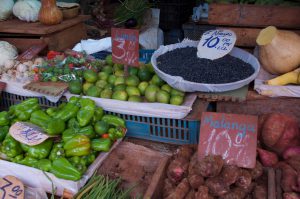
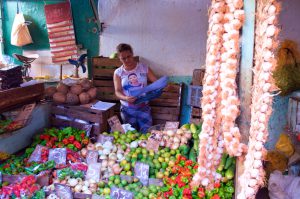
After one final clearance and a farewell to the harbor pilots, we head out into the channel just as a tropical storm breaks—bringing thunder, lightning, and torrential rain. It’s pretty strange to leave Havana in this kind of weather after three days of blazing sun and crippling heat. But there’s an upside: the sudden storm means a temporary break in the headwind we’ll be fighting until we get to Santo Domingo. There’s really no way to avoid it. After talking about it at length and analyzing the weather charts, we finally decided to take the northern route on the windward side of the islands. It’s 150 miles shorter than the southern route that we had originally planned to take because of cyclone activity. That would be the icing on the cake!
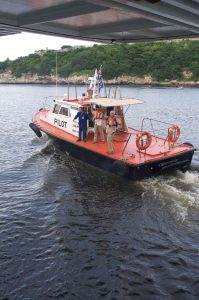
We’re now a small crew of only eight people. That makes life a whole lot easier for Olivier and Bérangère, who’ve been feeding a small army of about 15 people every day. Our lovely First Mate Annelore gives us a safety briefing, Olivier organizes the chore charts for cooking, cleaning, putting things away, and life on board is starting to take shape. At night, we’ll do three-hour watch shifts in pairs. Today, our first day at sea, I drew the midnight to 3 AM shift. It’s not so bad. Actually it’s kind of a shock when you’re used to being up on the deck of a racing sailboat, where the first task is to adjust the sails. The first time I went up on Race for Water’s bridge, I automatically looked for the mast. On board Race for Water it feels like magic: gliding over the sea in total silence. Tonight, the winds have died down and the ocean is calm, bathed in the milky light of the full moon. A few years back, in Polynesia, I got to dive with some huge manta rays. I couldn’t believe how sleek and elegant they were, as they rippled through the water. And tonight, in the moonlight, Race for Water feels like that, with her solar-panel wings extended like a manta ray. Believe me!
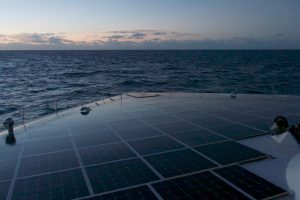
Eric Loizeau